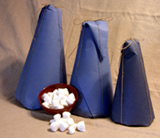Whenever we travel I make sure to take plenty of projects with me--you just never know when
you'll have some down time--a flight delay, long plane ride, or just plain boredom.
This past trip I took a UFO that I found in the bottom of the bin before I left.
I faintly remember when I bought this
pattern from
Crabapple Hill--oh dear! I just flipped to the website and saw another
pattern I want to do! Anyway, I like their patterns and this one was no exception--just
let it age way too long! And with fall approaching, it was time to get to it!
So, I traced off the pattern, gathered my supplies and packed!
Luckily, I had this box of Crayolas--I LOVE Crayolas! Just love them!
I have several boxes, tins, special collections--and the worse thing about me--
I hate, yes, hate to use the Crayolas!! I Want to keep those sharp points, you know!
It was time to use these though--what am I saving them for?
I have no little grandkids anymore
This collection contains, 'retired' colors (hard to believe they retire some of my favorite colors!)
plus this box of 64 colors--just what is needed for this pattern. Then I'm looking at the pattern
and the colors--did you know there are such color names as 'goldenrod', dandelion, tumbleweed,
wisteria and macaroni & cheese!!? I never took the colors out of the box--I just collect!
It was a surprise to me!
you're saying--why do you need colors? Because with this pattern, you color first before
stitching--this was way too much fun! I enjoyed fondling my colors and reading each
name on the wrapper--I think I was good with the points too.
I know--Crazy me!








































